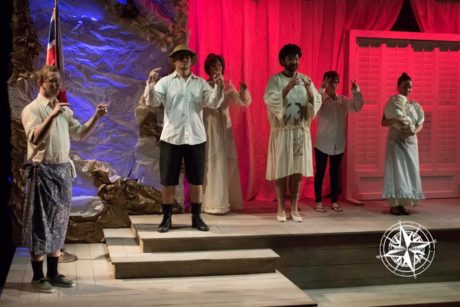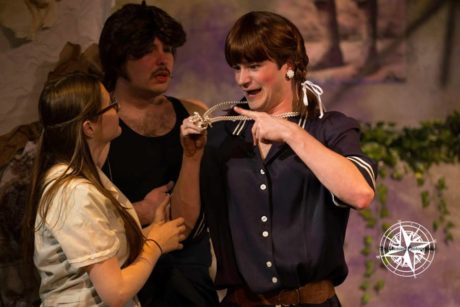Caryl Churchill’s Cloud Nine, which premiered in London in 1979, is rightly considered a landmark play. It’s pivotal for me personally as well, ever since I saw the legendary Tommy Tune production off-Broadway in 1981.
At the time I was immersed in counter-cultural people’s theater, which tended to be wildly experimental in form but often single-issue-focused in content.The women’s movement was making waves, and there were remarkable women playwrights at work, mainly off-off-Broadway. But in commercial theater there were yet few plays that looked at the world through the lens of women’s lived experience (the singular exception being Ntozake Shange’s 1975 for colored girls who have considered suicide / when the rainbow is enuf, recently and wonderfully revived at Theater Alliance).
Churchill’s Cloud Nine exploded my consciousness about what was possible to do and say in theater about the intersecting hierarchies of sex, race, and class all in the same play. From a shrewdly woman-centric, anti-imperialist viewpoint, Churchill dramatizes that interlocking-oppression matrix with scathing wit, surreal comedy, and inspired strokes of cross-gender, cross-race, and cross-generation casting.

When the play premiered, half of it was a period piece, and nowadays both halves are. Act I is set in Victorian colonial Africa, and Act II is set 100 years later in a London in 1979. Some of the characters in Act I reappear in Act II but have aged only 25 years. It’s one of those time-and-place stunts that make theater so much fun.
As freshly reimagined by Director Monique Holt, Gallaudet’s revival of Cloud Nine is start to finish a delight, with unexpected twists. Performed on Gallaudet’s superb black box stage in artistic sign language by actors playing pointedly to the audience—and simultaneously spoken aloud by voice actors in the back of the house—the production is widely accessible. Intriguingly, it also takes on a new dimensional quality. It’s as if Churchill’s classic text has been given a meta layer of meaning that makes it seem all the more relevant to our times.
In Act I, an imperious British officer named Clive (a properly pompous Gregg McConville, Jr.) has been posted to Africa to oversee the Crown’s dubious interests. His wife Betty, a part meant to be played by a man, is a sendup of submissive feminine frailty (“I am man’s creation…what men want is what I want to be,” she flutters—and a sensitive Andrew Morrill keeps her from seeming a cartoon). Their black manservant is Joseph, who considers his own people “bad people” (“What white men want, I dearly want to be”). The part is meant to be played by a white actor (and William Millios’ performance in the role is particularly impressive during two monologues, a moving “In the Bleak Midwinter” and a fiercely unbiblical creation myth). Betty’s scolding mother, also Clive’s adoring mother-in-law, is Maud (a genteelly judgmental Caldonia Wilding). Edward, Clive and Betty’s son, meant to be played by a woman (a spunky Christy Zendarski), is having a hard time becoming the man his father wants him to be as he much prefers to play with dolls.
The sexual attractions go every which way.
A spirited widow arrives seeking safety from restless natives, Mrs. Saunders (a feisty Chelsea Hilaire), and Clive promptly makes carnal moves on her (his head up under her skirt at one point). A brave and butch explorer arrives for a visit, a friend of Clive’s named Mr. Harry Bagley (a stalwart Thadeus Suggs), and we learn he’s got a bro crush on Clive, and Edward has a boy crush on Harry. Meanwhile Betty has a thing for Harry, and Edward’s governess, Ellen (a winsome Jacinda Baldwin-Gomez), wants Betty real bad.
Scenic Designer Samina Vieth creates a crushed-paper-surface proscenium with a subtle map of Africa and portrait of Queen Victoria on either side. In Act I this unit frames a louvered double door draped by pastel crushed silk. Lighting Designer Annie Wiegand makes it all look lovely lit from the front and vaguely ominous lit from behind, as when actors appear in shadow. Costume Designer’s chooses an all-white wardrobe for all except the assimilated sycophant Joshua, who wears white from the waist up but a dark-pattered sarong below. Detailing is not stitched on but drawn on, lending everyone a doll-like appearance, nicely enhanced by Make-up Artist Nikolya Sereda’s rosy cheeks and penciled-on raised eyebrows. Taken together these stage arts and the stylized acting evoke an enchanting live-action Victorian puppet show.

The script suggests that the characters in Act II be played by the same actors who did Act I, with some switcheroo swapping: Betty II is to be played by the woman who played Edward I, Edward II is to be played by the man who played Betty I, and so on. Monique Holt instead chose a different cast for the the Act II characters. As Holt explained to me, not only did this increase the number of roles available; it offered hard-to-come-by training in understudying, because the Act I cast also learned the Act II roles, and vice versa.
In Cloud Nine’s Act II, the colonial history satirized in Act I is never mentioned. Instead we get an assortment of contemporary personal relationship issues without any particular social context other than the generic hip 70s, depicted in this production by a backdrop of slogans, spray painting, and posters.
Betty is making her way in the world solo, having left Clive, and Emma Crawford gives Betty’s journey to find herself a touching soulfulness. Betty’s daughter, Victoria, represented by a doll prop in Act I, is now married unhappily to Martin, a man who uses trendy liberationist sensitivity to belittle her. The scene where this falls out between Phil Meredith (as Martin) and Allyson Bortoletto (as Victoria) was sharply played and a highpoint. Betty’s son, Edward, is now a gardener and in a gay relationship with Gerry, who does not reciprocate Edward’s romantic attachment. The scene where this emotional distance becomes clear between Ryan Barrett (as Edward) and Eric Murphy (as Gerry) was touchingly played, and Murphy’s handling of Gerry’s subsequent graphic monologue about cruising was exceptional. Victoria, rebounding from Martin, seeks sexual solace with a lesbian single mother named Lin, played with fine forthrightness by Caroline Suggs. Lin’s daughter Cathy, played by a man (a rambunctious and tempestuous Gideon Firl), is a tomboy who likes guns. In a quirky but typically 70s communal commingling, Lin and Victoria and Edward all end up living together—and then Edward discloses he himself might be lesbian and maybe a woman too.
An able cast of six voice actors, led by Voice Director Corrie Pond, delivered Churchill’s dialog with verve and nuance and credibly portrayed vocally all 16 different characters: Joshua Cauley, Aaron Halleck, Ben Lauer, Malka Roth, Samantha R. Smith, and Samantha Fina. Jesse Conrad and Stephen Kimble were the ASL/BSL Sign Coaches.
Gallaudet’s excellent and entertaining mounting of Caryl Churchill’s Cloud Nine is a terrific testament to the prescience, provocation, and political acumen of this important modern classic.
Running Time: Two hours 30 minutes, including one intermission.
Cloud Nine presented by the Gallaudet University Theatre and Dance Program plays through April 24, 2016 at the Eastman Studio Theatre in the Elstad Annex of Gallaudet University – 800 Florida Avenue. NE, in Washington, DC. All performances are signed and voice interpreted except Saturday matinees, which are signed only. For tickets, purchase them online.
RATING:





